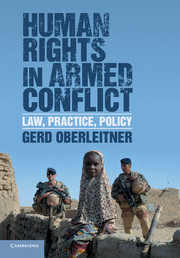Book contents
- Frontmatter
- Contents
- Acknowledgments
- Table of cases
- Table of Legal Instruments
- List of Abbreviations
- Introduction
- Part I Human rights in armed conflict: history of an idea
- 1 From medieval sources to modernity
- 2 The science of warfare and the progress of civilization
- 3 1945: whither war?
- 4 Human rights in armed conflict
- Part II Human rights and humanitarian law: theory
- Part III Human rights and humanitarian law: challenges and commonalities
- Part IV The dynamics of war and law
- Part V Enforcement: practice and potential
- Conclusion
- Bibliography
- Index
- References
4 - Human rights in armed conflict
Published online by Cambridge University Press: 05 March 2015
- Frontmatter
- Contents
- Acknowledgments
- Table of cases
- Table of Legal Instruments
- List of Abbreviations
- Introduction
- Part I Human rights in armed conflict: history of an idea
- 1 From medieval sources to modernity
- 2 The science of warfare and the progress of civilization
- 3 1945: whither war?
- 4 Human rights in armed conflict
- Part II Human rights and humanitarian law: theory
- Part III Human rights and humanitarian law: challenges and commonalities
- Part IV The dynamics of war and law
- Part V Enforcement: practice and potential
- Conclusion
- Bibliography
- Index
- References
Summary
Geneva, New York, Tehran: World Conference of Human Rights 1968
In the years following the adoption of the Geneva Convention and the Universal Declaration of Human Rights, the “tacit acceptance” of two separate legal regimes persisted. The one notable exception to the United Nations’ lack of interest in the laws of war was the concern which the United Nations Educational, Scientific and Cultural Organisation (UNESCO) showed for the protection of cultural values in armed conflicts in the 1954 Hague Convention on Cultural Property and its two Protocols. The International Committee of the Red Cross (ICRC) also remained sceptical of human rights for various reasons. First, the organization’s approach to any law, including international humanitarian law, was a pragmatic one: it sought to provide relief rather than pursue justice. The ICRC was concerned that human rights would not deliver what they promised, and the lack of binding treaty obligations on human rights on the universal level until the two UN Covenants (on civil and political rights and on social, economic and cultural rights) entered into force in 1976, together with the absence of any meaningful monitoring mechanism led the organization to question the potential of human rights. The ICRC thought of the growing human rights movement as a somewhat utopian project, striving for the perfect world but achieving nothing. In comparison, it considered international humanitarian law as capable of protecting concrete persons in real life.
- Type
- Chapter
- Information
- Human Rights in Armed ConflictLaw, Practice, Policy, pp. 52 - 80Publisher: Cambridge University PressPrint publication year: 2015
References
- 1
- Cited by



